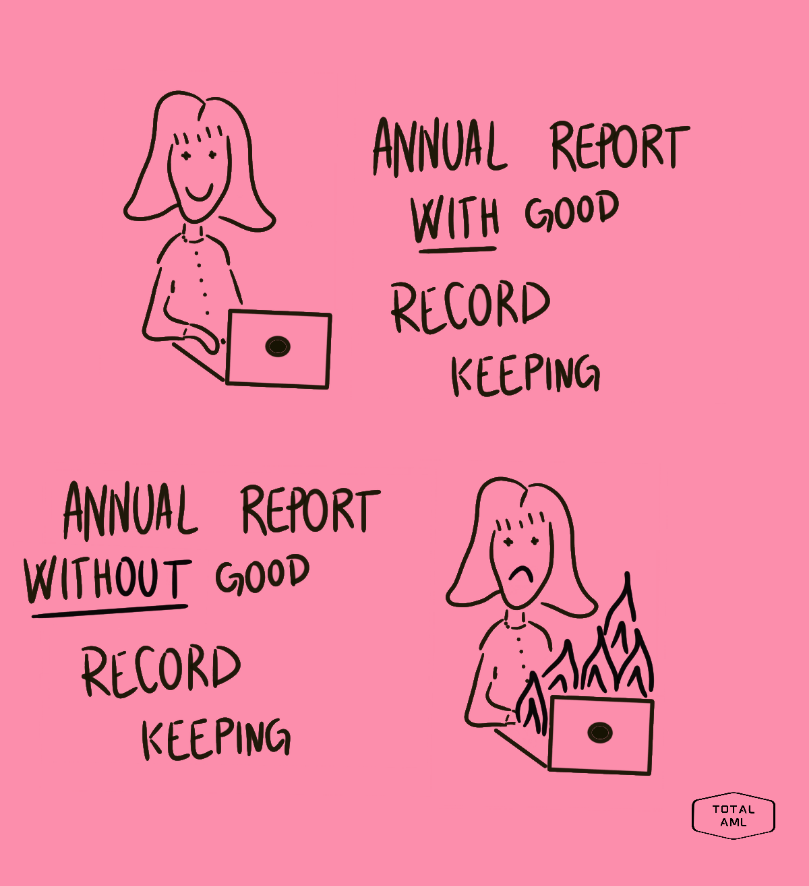(AML annual report – 5 minute read)

Today we have a guest post from Giulia Dondoli from Total-aml.com. They are a provider of expert AML advisory services. Giulia talks about how you can get on top of your AML obligations (if you have any).
Its AML Annual Report season!
It’s AML/CFT Annual Report season. All New Zealand reporting entities need to submit their AML/CFT Annual Report to their AML/CFT Supervisor between 1 July 2023 to 31 August 2023. If you are a reporting entity, this post is for you!
Financial institutions and some other sectors (e.g. real estate agents and accountants) are vulnerable to money laundering and terrorism financing. This is because money launderers can use these types of business for concealing the source or the destination of funds derived from criminal activities.
Money Launderers need to disguise the link between their financial sources and themselves to continue to finance their illegal activities undisturbed. The techniques used to launder money and to fund terrorism are similar.
To combat such threats, the international community has developed standards of AML/CFT compliance, and New Zealand had followed suit with the Anti-Money Laundering and Counter Financing of Terrorism Act (the Act), which aims to detect and deter ML/FT. The Act prescribes numerous requirements for reportingentities, and, as the name suggests, one of the main requirements is to report back to the AML/CFT Supervisors.
Do you need to submit an AML Annual Report?
Only reporting entities need to submit Annual Reports. To find out if you are a reporting entity, check Section 5 of the Act, which provide a list of activities captured by the Act. If still in doubt, you should probably seek legal advice.
Annual Reports are important tools for the AML/CFT Supervisors. The information you provide in your Annual Report will help your AML/CFT Supervisor to understand: (a) your business and your sector, and (b) the money laundering threats that you, and other business in your sector, face.
Consequently, Annual Reports help the AML/CFT Supervisors to better target their resources to areas of high risks. Because of all these reasons, failing to provide accurate information in your Annual Report will be treated as a material non-compliance. Particularly so when your risk profile results reduced by your inaccurate Annual Report.
Here are some practical steps to ensure that your Annual Report is timely and accurate.
Be Prepared
Make sure that the information required for the Annual Report is available to you before you start the process.
Each AML/CFT Supervisor has their own Annual Report questionnaire. But, in general, you can expect to be asked to provide information in relation to:
- Contact Details – your business and AML/CFT Compliance Officer’s contact details.
- Organisational Structure – Details about your business, branches, number of staff and subsidiaries.
- Details of your Designated Business Group (if applicable).
- Risk Assessment and Compliance Programme – Details about your business’ risks, policies,
- procedures and controls, internal reviews and audit.
- Products and services your business offers.
- Customers/clients – Total number of customers you have done customer due diligence on, number
- of customers who are politically exposed persons, trusts, overseas government bodies, New Zealand
- residents, and non-residents.
- Volume and value of transactions.
- Methods you used to carry out customer due diligence.
Record Keeping for The Annual Report
The information required in the Annual Report needs to cover the period from 1 July 2022 to 30 June 2023. The key to a successful Annual Report is an effective record keeping process throughout the year.
Record keeping is the cornerstone of AML/CFT. Developing solid record keeping procedures, with clear responsibilities and oversight, will help you to comply with your AML/CFT requirements.
Big and complex companies may have sophisticated software for record keeping. However, there is no prescribed form of record keeping, and spreadsheets and file notes may be perfectly fine for many small reporting entities.
The most important thing is that you familiarise yourself (and make sure that your staff is familiar) with the requirements of the Annual Report, so that your business can keep on top of record keeping.
Start Early on Your AML Annual Report
You can submit your Annual Report at any time from 1st of July 2023 to 31st of August 2023. Avoid waiting until the end of August to prepare your Annual Report, as many aspects can cause delay.
First, information gathering may be time consuming. You will need to provide information on your staff, on your customers, on your transactions, etc. Usually, this information is scattered among several registers and files. Start reconciliating the information as soon as possible.
Second, you will need a RealMe account to be able to submit your Annual Report. If you do not have one already, it might take you a few days to register.
Third, the senior management needs to have oversight of the Annual Report process and, as best practice, they should approve the Annual Report before this is finalised and submitted. This could also be a time-consuming task, as obtaining an approval from your busy Board of Directors, or coordinating between several senior managers, can be a complex and slow process.
Where to Find More Information
Check out these helpful websites!
Still unsure on what to do for your AML annual report?
Giulia and her team will be happy to help you with any queries. Flick them an email at giulia@total-aml.com and check out their website at www.total-aml.com

